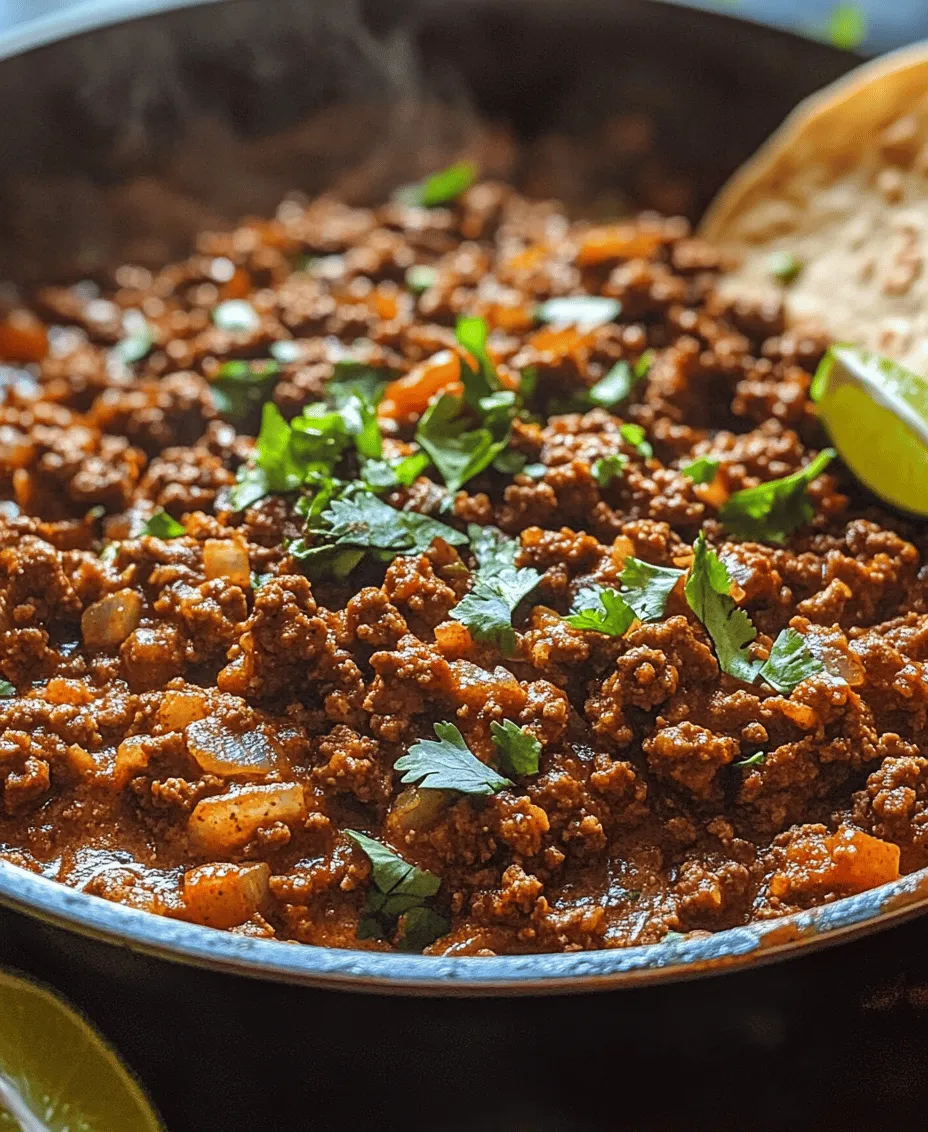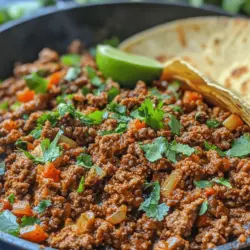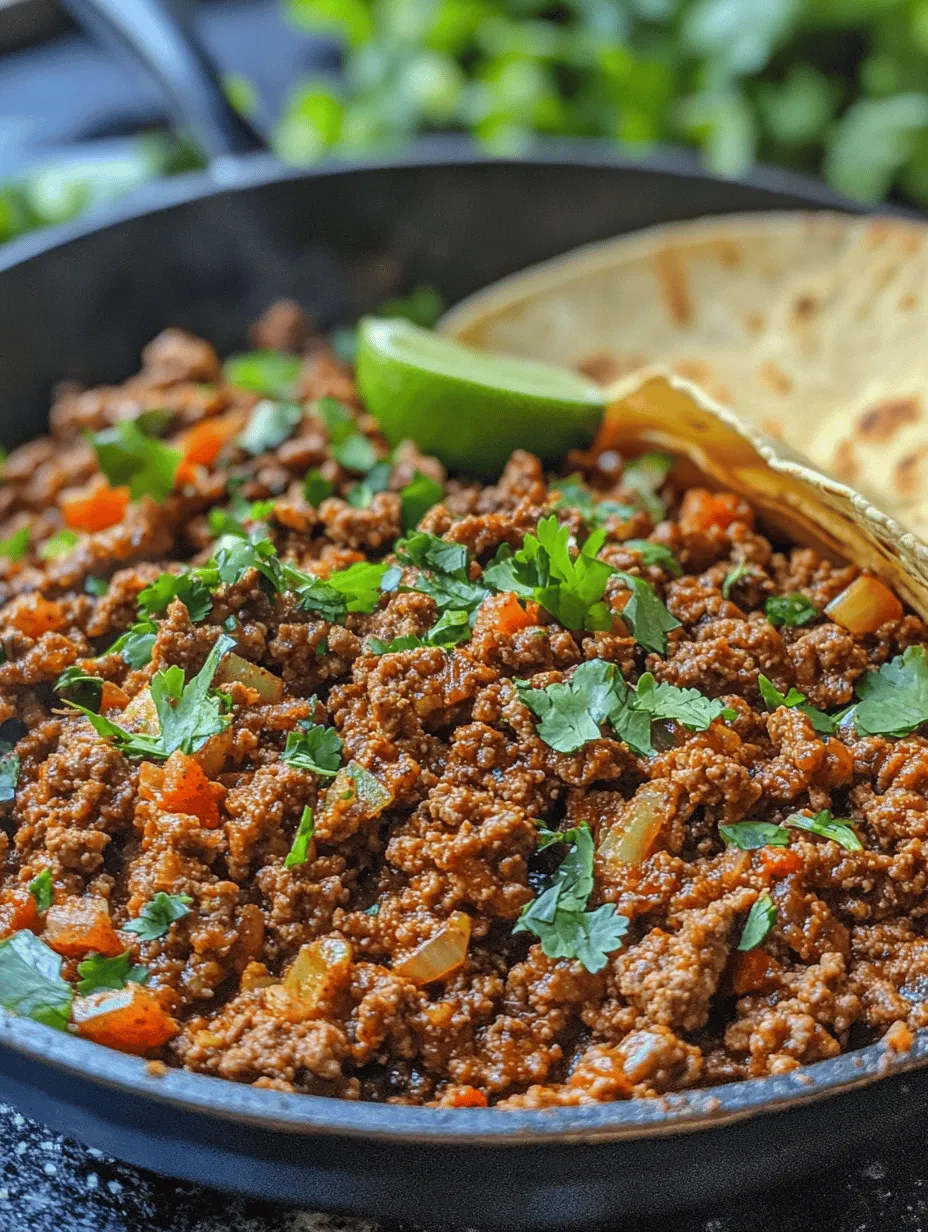Introduction to the Ultimate Taco Meat Recipe
Tacos are more than just a meal; they are an experience that transcends borders and cultures. With roots deeply embedded in Mexican cuisine, tacos have become a beloved staple in many culinary traditions worldwide. Their allure lies in their versatility, allowing for endless combinations of ingredients and flavors, all neatly wrapped in a soft or crispy tortilla. Whether it’s a casual weeknight dinner or a festive gathering, tacos offer a fun and delicious way to bring people together.
In this article, we present a comprehensive guide to creating the ultimate taco meat recipe. This dish is simple yet incredibly satisfying, making it the perfect choice for taco enthusiasts and novices alike. Utilizing ground beef or turkey, this taco meat is packed with flavor and can be customized to suit any palate. Get ready to impress your family and friends with a taco night they won’t soon forget.
The Importance of Quality Ingredients in Taco Meat
To create a taco meat that stands out, it’s crucial to start with high-quality ingredients. Each component plays a vital role in developing the rich flavors and satisfying textures that make tacos so irresistible. Let’s explore the key ingredients that elevate your taco meat from ordinary to extraordinary.
Ground Meat Selection: Comparing Ground Beef vs. Ground Turkey
When it comes to choosing the right protein for your taco meat, ground beef and ground turkey are the two most popular options. Ground beef is traditionally used in many taco recipes, offering a rich, robust flavor that pairs beautifully with the spices and seasonings. It has a higher fat content, which contributes to a juicy texture, making it ideal for those who appreciate a savory, hearty dish.
On the other hand, ground turkey is a leaner alternative that can be just as flavorful when seasoned correctly. It’s a popular choice for those looking to reduce their fat intake without sacrificing taste. By opting for ground turkey, you can create a lighter version of taco meat that still delivers on flavor. Ultimately, the choice between ground beef and ground turkey comes down to personal preference and dietary needs.
The Role of Aromatics: The Significance of Onion and Garlic
Aromatics are essential to building a flavorful base for your taco meat. The combination of onion and garlic adds depth and complexity, enhancing the overall taste of the dish. Onions, when sautéed, become sweet and caramelized, providing a savory foundation. Garlic, on the other hand, adds a pungent, aromatic quality that elevates the flavor profile.
To achieve the best results, it is vital to properly sauté the onion and garlic. This process allows their natural sugars to caramelize, creating a rich and fragrant base that infuses the meat with flavor. The balance of these aromatics can make a significant difference, setting the stage for a delicious taco experience.
Spices That Make a Difference: A Breakdown of Essential Spices
The magic of taco meat lies in its spices. A well-rounded blend of seasonings can transform a simple dish into a flavor-packed delight. Common spices used in taco meat include chili powder, cumin, paprika, and oregano.
– Chili Powder: This spice adds a mild heat and earthy flavor, making it a staple in taco seasoning.
– Cumin: Known for its warm, nutty taste, cumin enhances the overall flavor profile and is often used in Mexican cuisine.
– Paprika: This spice adds a sweet, smoky note, which complements the richness of the meat.
– Oregano: A hint of dried oregano brings a fresh, herbal note that balances the other spices.
These spices can be adjusted to taste, allowing you to customize the heat level and flavor intensity of your taco meat. For those who enjoy a kick, consider adding cayenne pepper or crushed red pepper flakes for extra heat.
Liquid Components: The Impact of Broth and Sauces on Flavor and Texture
In addition to spices, liquid components play a crucial role in achieving the perfect taco meat. Using broth or sauces can enhance the flavor and texture, preventing the mixture from becoming too dry. Chicken or beef broth can add moisture and depth, while sauces like tomato sauce or salsa can introduce acidity and richness.
When adding liquid ingredients, it’s essential to strike a balance. Too much liquid can result in a soupy consistency, while too little can lead to dry meat. The goal is to create a flavorful mixture that holds together well and can be easily spooned into tortillas.
Preparation Steps for the Ultimate Taco Meat
Now that we understand the importance of quality ingredients, it’s time to dive into the preparation steps for creating the ultimate taco meat. Follow these detailed instructions for a delicious result that will have everyone coming back for seconds.
Heating the Oil: The Foundation for Flavor
Begin by selecting a large skillet or sauté pan. Place it over medium heat and add a tablespoon of oil—olive oil or vegetable oil works best. Heating the oil before adding any ingredients is crucial as it helps to develop the flavors right from the start. Once the oil is shimmering, you’re ready to proceed to the next step.
Sautéing Aromatics: Techniques for Achieving the Perfect Onion and Garlic Base
Once the oil is heated, add a finely chopped onion to the skillet. Sauté the onion for about 4-5 minutes, or until it becomes translucent and begins to caramelize. Stir occasionally to ensure even cooking. After the onion has softened, add minced garlic and continue to sauté for an additional 1-2 minutes. Be careful not to burn the garlic, as it can become bitter. The aroma of the onion and garlic will fill your kitchen and set the stage for a flavorful taco meat.
Browning the Meat: Tips for Achieving a Rich, Brown Color
With the aromatics sautéed to perfection, it’s time to add your ground meat. Whether you’ve chosen ground beef or turkey, carefully crumble it into the skillet. Use a wooden spoon or spatula to break up the meat into smaller pieces. Allow the meat to brown without stirring too frequently; this helps develop a rich, caramelized color on the surface. Depending on the type of meat you use, this process should take around 6-8 minutes. Make sure to cook the meat until it is no longer pink and has reached a safe internal temperature.
Incorporating Spices: How to Ensure Even Distribution of Flavor
Once the meat is browned, it’s time to incorporate the spices. Sprinkle the chili powder, cumin, paprika, oregano, and any additional spices you desire over the meat mixture. Stir well to evenly distribute the spices throughout the meat. This step is crucial, as it ensures that every bite is packed with flavor. Allow the spices to toast for about a minute, which will enhance their aroma and taste.
Adding Liquid Ingredients: Best Practices for Mixing and Simmering
After the spices have been incorporated, it’s time to add your liquid components. Pour in your choice of broth and any sauces you are using. Stir to combine all the ingredients well. The liquid should not completely cover the meat but should be enough to create a moist mixture. Bring the mixture to a gentle simmer, allowing the flavors to meld together.
Simmering the Mixture: Creating the Right Texture and Depth of Flavor
Reduce the heat to low and let the taco meat simmer for about 10-15 minutes. This step is essential for developing a deeper flavor and achieving the desired texture. During this time, the liquid will reduce slightly, thickening the mixture and enhancing the overall taste. Stir occasionally to prevent sticking and ensure that the meat cooks evenly.
Final Taste Test: Importance of Adjusting Seasonings
As your taco meat simmers, take the time to taste and adjust the seasonings as needed. This is your opportunity to personalize the flavor to your liking. If you prefer a spicier kick, consider adding more chili powder or a splash of hot sauce. Conversely, if you find the mixture too salty or potent, add a splash of broth to mellow out the flavors. A final taste test ensures that your taco meat is just right before serving.
—
By following these steps, you will create a taco meat that is flavorful, juicy, and perfect for filling your tortillas. Stay tuned for the next part of our guide, where we will explore creative serving suggestions that will take your taco night to the next level.

Taco Assembly Options: Different Tortilla Types and Toppings
When it comes to assembling tacos, the choices are virtually limitless, allowing you to create a personalized experience for every palate. First, let’s discuss the various tortilla types you can use.
Tortilla Types
1. Corn Tortillas: These are traditional and gluten-free, offering a slightly nutty flavor that complements the taco meat beautifully. They tend to be more fragile, so handling them with care is essential.
2. Flour Tortillas: Soft and pliable, flour tortillas can hold up to a generous filling without tearing. They’re a popular choice for those who prefer a milder taste.
3. Hard Shells: For a crunchy texture, hard taco shells are a favorite. They provide a delightful contrast to the meat, but be cautious as they can crumble easily.
4. Lettuce Wraps: For a low-carb or gluten-free option, using large lettuce leaves (like romaine or iceberg) as a wrap can be refreshing and light.
Toppings
The beauty of tacos lies in the endless topping options available. Here are some classic and creative choices to consider:
– Cheese: Shredded cheddar, crumbled queso fresco, or a sprinkle of cotija can add creaminess.
– Sour Cream or Greek Yogurt: A dollop of sour cream or Greek yogurt balances the spices and adds a creamy texture.
– Salsa: Choose from fresh pico de gallo, salsa verde, or a spicy salsa to add vibrant flavor and freshness.
– Guacamole: Creamy guacamole provides richness and pairs beautifully with the seasoned meat.
– Vegetables: Chopped onions, diced tomatoes, shredded lettuce, and jalapeños add crunch and freshness.
– Herbs: Fresh cilantro and green onions can enhance the flavor profile and add a pop of color.
With these tortilla and topping options, you can customize every taco to suit your preference, making each bite a unique experience.
Pairing with Sides: Complementary Dishes to Enhance the Meal
To create a well-rounded meal, consider serving your tacos with complementary side dishes. Here are a few excellent options that pair wonderfully with taco meat:
– Mexican Rice: Fluffy and seasoned rice adds a filling element to your meal. You can prepare it with tomatoes, bell peppers, and spices for an added flavor boost.
– Refried Beans: A side of refried pinto or black beans provides protein and fiber, making your meal more satisfying.
– Corn on the Cob: Grilled or boiled corn, brushed with butter and sprinkled with chili powder and lime, brings sweetness and a bit of heat.
– Chips and Salsa: Tortilla chips with a side of salsa or guacamole are always a hit as an appetizer.
– Salad: A light salad with fresh greens, avocados, and a zesty lime dressing can balance the richness of the tacos.
By incorporating these sides, you can elevate your taco night to a full fiesta, pleasing everyone at the table.
Garnishing for Flavor and Presentation: The Role of Cilantro and Lime
Garnishing your tacos not only enhances their flavor but also improves presentation. Two essential garnishes for tacos are cilantro and lime.
Cilantro
Fresh cilantro adds a burst of freshness and a hint of citrus to tacos. It complements the savory taco meat beautifully, cutting through the richness. Just sprinkle chopped cilantro over the assembled tacos for a pop of color and flavor.
Lime
A squeeze of fresh lime juice over your tacos brightens the flavors and adds acidity, which balances the spices in the meat. Lime wedges served on the side allow diners to customize their tacos to their taste.
Together, cilantro and lime transform your tacos into a vibrant and flavorful dish, making them visually appealing and delicious.
Variations of Taco Meat
While the classic taco meat recipe is a crowd-pleaser, exploring variations can cater to different tastes and dietary preferences. Here are some exciting alternatives to consider:
Spicy Taco Meat
For those who enjoy a kick, adjusting the heat levels in your taco meat is easy. Consider adding diced jalapeños to the meat mixture or a sprinkle of cayenne pepper to the seasoning. If you prefer a smoky heat, chipotle powder can elevate the flavor profile. Always taste as you go and adjust according to your heat tolerance.
Vegetarian and Vegan Alternatives
If you’re looking for a meat-free option, there are several delicious alternatives:
– Lentils: Cooked lentils can mimic the texture of ground meat while soaking up flavors from spices and sauces.
– Mushrooms: Finely chopped mushrooms provide a savory, umami flavor and a meaty texture.
– Plant-Based Meat: Many brands offer ground meat alternatives made from pea protein or soy, which can be seasoned similarly to traditional taco meat.
Experimenting with these plant-based options allows you to enjoy tacos without sacrificing flavor or texture.
Global Influences
Incorporating flavors from different cuisines can elevate your taco experience. Here are a few ideas:
– Korean Tacos: Use bulgogi (marinated beef) and top with kimchi for a spicy and tangy twist.
– Thai Tacos: Season your meat with Thai spices and add a peanut sauce drizzle for a unique flavor combination.
– Mediterranean Tacos: Use seasoned ground lamb or beef, topped with tzatziki sauce and feta for a refreshing twist.
These variations showcase how versatile taco meat can be, allowing you to explore global flavors while enjoying a beloved dish.
Nutritional Information of Taco Meat
Understanding the nutritional aspects of your taco meat can help you make informed choices. Here’s a breakdown of the key components:
Caloric Breakdown
The caloric content of taco meat largely depends on the type of meat used and the seasonings added. For instance, ground beef typically has more calories than ground turkey or chicken. On average:
– Ground Beef (80% lean): Approximately 250 calories per 3-ounce serving.
– Ground Turkey (93% lean): Roughly 170 calories per 3-ounce serving.
– Vegetarian Options (like lentils): About 120 calories per 1 cup.
Healthy Substitutions
To lower calories without sacrificing flavor, consider these substitutions:
– Lean Meats: Use lean cuts of meat such as ground turkey or chicken.
– Skip the Cheese: Opt for a sprinkle of nutritional yeast for a cheesy flavor without the calories.
– Avoid Sour Cream: Substitute with Greek yogurt for a healthier and protein-rich alternative.
Balanced Meals
Incorporating taco meat into a balanced diet is feasible. Pairing it with whole grains, such as brown rice or whole-grain tortillas, and plenty of veggies creates a nutrient-rich meal. Additionally, controlling portion sizes can help maintain a healthy balance.
Common Mistakes to Avoid When Making Taco Meat
To ensure your taco meat is delicious every time, here are common pitfalls to avoid:
Overcooking the Meat
Timing is crucial in taco meat preparation. Overcooking can lead to dry, tough meat. Aim for a juicy texture by cooking the meat until it’s no longer pink but still moist. Use a meat thermometer to check for doneness—160°F is the safe internal temperature for ground meats.
Under-seasoning
Seasoning is key to flavorful taco meat. Don’t be afraid to experiment with spices! If your taco meat tastes bland, consider adding more chili powder, cumin, or garlic for an extra flavor punch. Always taste and adjust as needed during cooking.
Ignoring Texture
Texture is just as important as flavor. Ensure your taco meat has a nice consistency by not overcrowding the pan while browning. Overcrowding can steam the meat instead of allowing it to brown, leading to a less desirable texture.
Conclusion: Enjoying the Ultimate Taco Meat Recipe
Preparing and enjoying the ultimate taco meat recipe is a delightful experience that brings joy to the table. This dish is perfect for a variety of occasions, from casual family dinners to lively gatherings with friends. The versatility of taco meat allows for creativity in presentation and serving, catering to different tastes and dietary preferences.
The simplicity of the preparation, combined with the depth of flavor that comes from the right spices and ingredients, makes this recipe a must-try for any taco lover. Whether you stick to the classic version or explore the many variations, the ultimate taco meat is sure to be a crowd-pleaser. So gather your loved ones, set out the toppings, and enjoy a taco night that everyone will remember!


